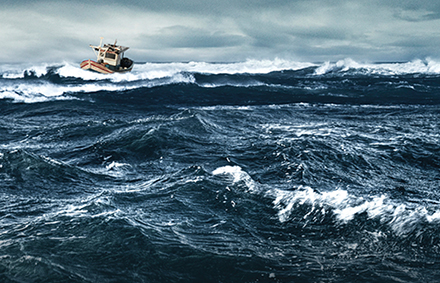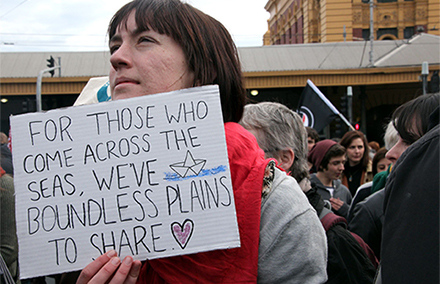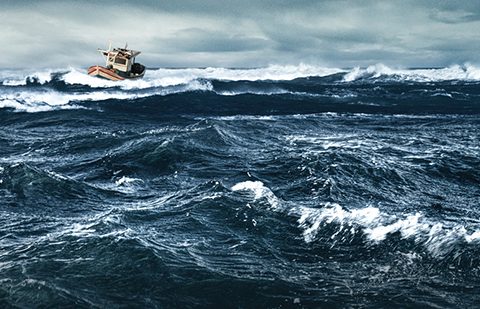
A long tradition of stopping the boats. Image: Australian government/ Wikimedia commons.
Has Australia ever had a humane asylum policy? A look at our response to the 1970s’ Indochinese crisis reveals a worrying trend.
Australia’s current asylum policy is often compared with the country’s more humanitarian past.
Many have accused today’s government of defying a proud humanitarian tradition of welcoming persecuted people. “We used to be better than this”, the critics cry. They are referring to a more compassionate time when the Australian public welcomed asylum seekers and “took pity despite our misgivings”.
In 1976, Australia received its first “boat people” (besides the convicts, of course). Around 60 boats arrived, bringing some 2,000 people fleeing Indochina. Australia then resettled more than 185,000 Indochinese refugees as part of a global effort.
This global effort involved host countries allowing asylum seekers to stay while their cases were being assessed by resettlement countries, which agreed to fast-track their claims. Australian officials flew to regional camps and assessed those with claims to asylum before airlifting them to Australia, essentially preventing them from taking the precarious boat journey.
It is these policies that have been hailed as part of our proud humanitarian tradition. But were these actions really motivated by humanitarianism?
Truth be told, these policies were all about stopping the boats, and they always have been. In the face of the 1976 crisis, Australia did not help until it was forced to do so when boats began arriving on the nation’s shores.
When Australian officials began assessing asylum claims in the regional camps of Southeast Asia, they did so selectively and in a limited capacity. Refugees were selected on the basis of strict criteria, including health checks and work suitability. This ensured that the government exercised control over the “flow and quality” of those selected to be resettled.
This is why today’s government fears the boats.
Boat people choose us. They display agency in arriving on our shores, effectively undermining the government’s agency in selecting who can arrive (and the circumstances in which they can arrive). So the people-smugglers are painted as the “scum of the earth”, not so much for exploiting vulnerable people (after all, they are supplying a service for which there is demand), but for taking the control of who can come to Australia away from the government.
In 1996 the Howard government linked the Offshore Program (the refugees abroad we select to resettle), and the Onshore Program (those who have already made it to Australia and then apply for asylum from within). This meant that for every place granted to a person who had already arrived in Australia, a place was taken from those allocated to the Offshore Program.
This fed into the government’s narrative that boat people were “queue jumpers” and therefore robbing a “genuine” refugee from their place of safety.
Now that the government has “stopped the boats”, it can get on with the humanitarian task at hand – resettling those “real” refugees being robbed by boat people and people smugglers.

Photo: Takver on flickr https://www.flickr.com/photos/takver/
So why did it take the government so long to commit to resettling Syrian refugees after other industrialised countries had opened their doors? Aren’t we supposed to be a “good international citizen?” The government’s decision to resettle 12,000 Syrians above our quota (who will be subject to the same stringent testing used in the Indochinese crisis) is a start. But that is all it is.
Germany is set to resettle 800,000 Syrian refugees and Britain has committed to 20,000 over five years. This diminishes Australia’s claim to being a “good international citizen”; it is certainly not one who is leading the rest of the world. In fact, the crisis in Europe reminds us that we never really had a crisis.
Photographs of drowned children, stories of tragic desperation and Germans who meet asylum seekers upon their arrival with water, candy and blankets are moving the Australian public to demand we do more for the Syrian refugees.
Let us just spare a thought for those Syrians on Manus Island and Nauru, those Syrians who were on boats that we turned around, and those Syrians who very recently returned to Syria after reaching breaking point in Australian-run offshore detention centres.
This says a lot about how much government leadership can affect public responses. It’s time for some positive leadership. Contrary to ousted Prime Minister Tony Abbott’s belief, it is actually us who can learn a lot from other countries. The question now is whether new Prime Minister Malcolm Turnbull will take a different approach.
Either way, I suspect that maybe we never really were “better than this” at all. But this is a good opportunity to start. We can help more of the four million Syrian refugees.
After all, the “boats have stopped”.
Carly Gordyn is a PhD scholar researching the international refugee regime at the Australian National University’s Coral Bell School of Asia Pacific Affairs.
 Facebook
Facebook  Twitter
Twitter  Soundcloud
Soundcloud  Youtube
Youtube  Rss
Rss 